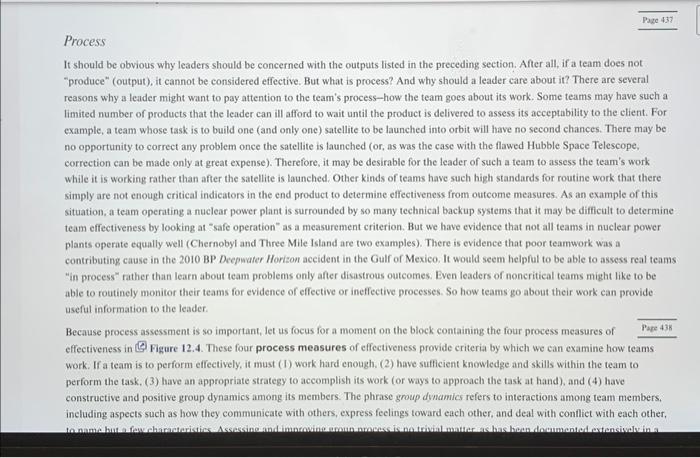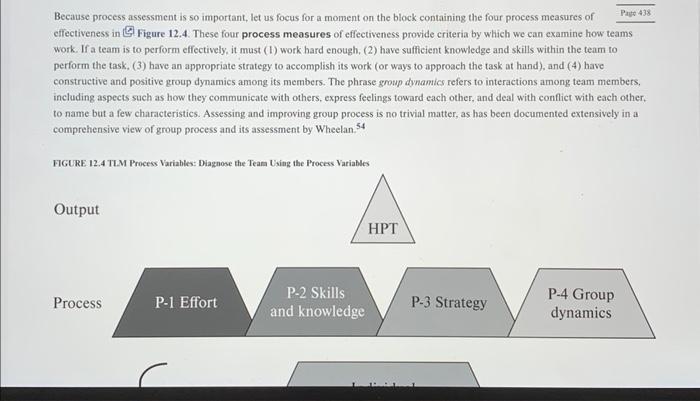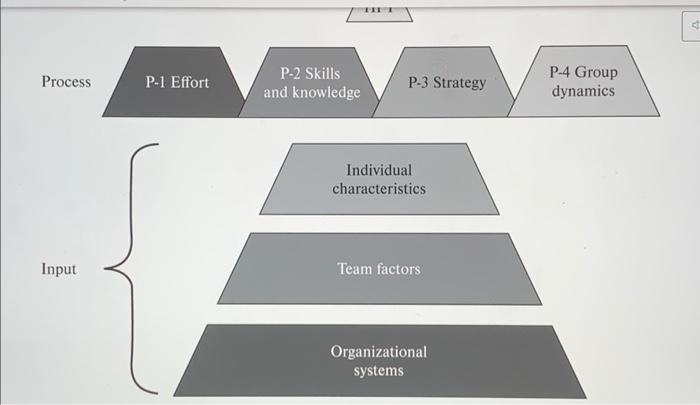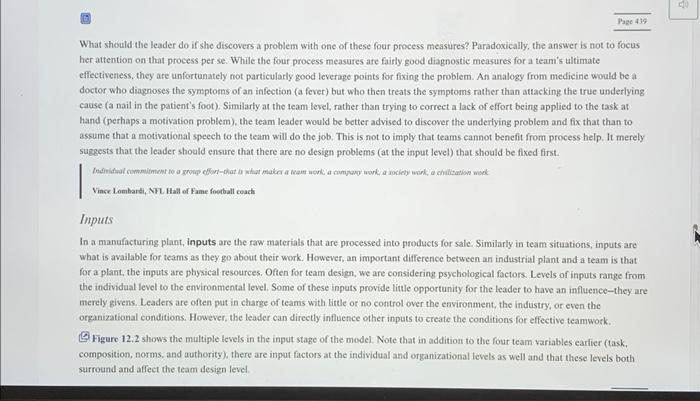Question 2. From the video, this team employed strategies and tactics that represent some part of effective team characteristics (see your textbook pp. 429-434). Whien you evaluate this team's effectivaness, how many characteristics can be appled? Find as mary as you can. Question 3. How about their team process? (see textbook p.437.439) Please describe their team process based on the textbook. Because process assessment is so important, let us focus for a moment on the block containing the four process measures of Patue438 effectiveness in 9 Figure 12.4. These four process measures of effectiveness provide criteria by which we can examine how teams work. If a team is to perform effectively, it must (1) work hard enough, (2) have sufficient knowledge and skills within the team to perform the task, (3) have an appropriate strategy to accomplish its work (or ways to approach the task at hand), and (4) have constructive and positive group dynamics among its members. The phrase group dynamics refers to interactions among team members, including aspects such as how they communicate with others, express feelings toward each other, and deal with conflict with each other. to name but a few characteristics. Assessing and improving group process is no trivial matter, as has been documented extensively in a comprehensive view of group process and its assessment by Wheelan. 54 FIGURE 12.4 TLM Process Variables: Diagnose the Tean Using the Process Variables It should be obvious why leaders should be concerned with the outputs listed in the preceding section. After all, if a team does not "produce" (output), it cannot be considered effective. But what is process? And why should a leader care about it? There are several reasons why a leader might want to pay attention to the team's process-how the team goes about its work. Some teams may have such a limited number of products that the leader can ill afford to wait until the product is delivered to assess its acceptability to the client. For example, a team whose task is to build one (and only one) satellite to be launched into orbit will have no second chances. There may be no opportunity to correct any problem once the satellite is launched (or, as was the case with the flawed Hubble Space Telescope, correction can be made only at great expense). Therefore, it may be desirable for the leader of such a team to assess the team's work while it is working rather than after the satellite is launched. Other kinds of teams have such high standards for routine work that there simply are not enough critical indicators in the end product to determine effectiveness from outcome measures. As an example of this situation, a team operating a nuclear power plant is surrounded by so many technical backup systems that it may be difficult to determine team effectiveness by looking at "safe operation" as a measurement criterion. But we have evidence that not all teams in nuclear power plants operate equally well (Chernobyl and Three Mile Island are two examples). There is evidence that poor teamwork was a contributing cause in the 2010 BP Deepwater Horizon aceident in the Gulf of Mexico. It would seem helpful to be able to assess real teams "in process" father than learn about team problems only after disastrous outcomes. Even leaders of noncritical teams might like to be able to routinely monitor their teams for evidence of effective or ineffective processes. So how teams go about their work can provide useful information to the leader. Because process assessment is so important, let us focus for a moment on the block containing the four process measures of Pare 43k work. If a team is to perform effectively, it must (1) work hard enough. (2) have sufficient knowedge and skills within the team to perform the task, (3) have an appropriate strategy to accomplish its work (or ways to approach the task at hand), and (4) have constructive and positive group dynamics among its members. The phrase group dynamics refers to interactions among team members, including aspects such as how they communicate with others, express feelings toward each other, and deal with conlict with each other, What should the leader do if she discovers a problem with one of these four process measures? Paradoxically, the answer is not to focus her attention on that process per se. While the four process measures are fairly good diagnostic measures for a team's ultimate effectiveness, they are unfortunately not particularly good leverage points for fixing the problem. An analogy from medicine would be a doctor who diagnoses the symptoms of an infection (a fever) but who then treats the symptoms rather than attacking the true underlying cause (a nail in the patient's foot). Similarly at the team level, rather than trying to correct a lack of effort being applied to the task at hand (perhaps a motivation problem), the team leader would be better advised to discover the underiying problem and fix that than to assume that a motivational speech to the team will do the job. This is not to imply that teams cannot benefit from process help. It merely suggests that the leader should ensure that there are no design problems (at the input level) that should be fixed first. Vince Lombardi, NTL. Ilall of Fame football coach Inputs In a manufacturing plant, inputs are the raw materials that are processed into products for sale. Similarly in team situations, inputs are what is available for teams as they go about their work. However, an important difference between an industrial plant and a team is that for a plant, the inputs are phyxical resources. Often for team design, we are considering psychological factors. Levels of inputs range from the individual level to the environmental level. Some of these inputs provide little opportunity for the leader to have an influence-they are merely givens. Leaders are often put in charge of teams with little or no control over the environment, the industry, or even the organizational conditions. However, the leader can directly influence other inputs to create the conditions for effective teamwork. (9) Figure 12.2 shows the multiple levels in the input stage of the model. Note that in addition to the four team variables earfier (task. composition, norms, and authority), there are input factors at the individual and organizational levels as well and that these levels both surround and affect the team design level











